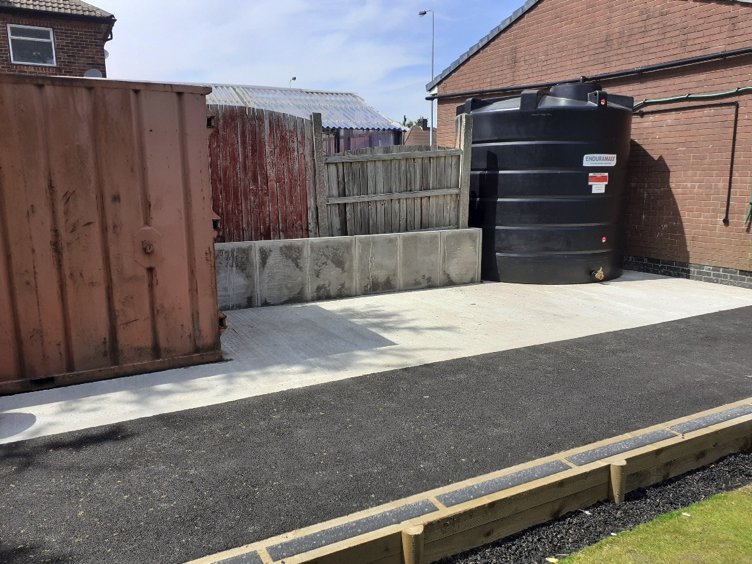Rainwater harvesting
Planter and rainwater harvester. Reproduced with permission, Dan Galbraith, Susdrainable
Rainwater harvesting (or attenuation) refers to the capture and storage of rainwater.
This not only eases the pressure on drainage and sewerage systems, but reduces utility costs and eases water supply challenges during heatwaves and droughts.
Rainwater harvesting can be conducted at various scales, from the use of water butts to harvest water from a shed or garage roof for use in a residential garden, to much larger scale harvesting for commercial buildings, or industrial and agricultural facilities.
North Chadderton Social & Bowling Club
North Chadderton Social & Bowling Club committee had a long-standing ambition to introduce a more sustainable watering system, reducing both the club’s environmental impact and operating costs.
Throughout 2020 and 2021 the club worked with Groundwork Greater Manchester to install a rainwater harvesting system. The system captures rain from the roof of the clubhouse, storing it in a large volume (10,000 litre) container. A pump and hose system fitted to the container pumps water to the bowling green as and when irrigation is required. Using harvested rainwater reduces operating costs, conserves drinking water resources and avoids charges for draining rainwater into the public sewer system.
The installation also acts as a sustainable urban drainage system. After the container fills with rainwater, it overflows into a soakaway, reducing pressure on the public drainage system and potentially reducing flood risk.
Rainwater Harvesting - North Chadderton Social and Bowling Club
Manchester City Football Club - playing surface rainwater harvesting
Rainwater Harvesting at Manchester City Football Club
In the Summer of 2021 MCFC used the planned replacement of the stadium pitch structure and ground works to install a new air flow and drainage system.The system captures moisture and rainfall and reuses it for irrigation.
The system is primarily used to manage the moisture content in the ground and aerate/heat the pitch surface evenly. It also allows for the storage of 500m3 water under the surface area of the pitch.
The new system has been in full use since the start of the 2021- 22 season.
The technology builds on an existing rainwater harvesting system at City Football Academy where an 8 million-litre reservoir alongside a potable water borehole provides all grey water and pitch irrigation needs.
The Club is working with partners to see how roof rainwater might be harvested and reused as potable water and even to potentially brew beer.
Poster in the toilets at the National Trust’s Quarry Bank Mill explaining the discolouration of harvested rainwater.
Challenges with rainwater harvesting
Although the principle of rainwater harvesting is straightforward, installing a system at scale is technically challenging, and requires specialist expertise.
Tanks can be prone to sedimentation, and pumps require regular maintenance. Additionally, ensuring harvested rainwater is safe for consumption requires treatment and filtering, increasing costs, risks and complexity to construction.
Harvested rainwater tends to be more commonly used for non-consumption purposes, such as toilet flushing, horticulture or playing surface irrigation. Some building tenants and users have expressed concern regarding the slight discolour of harvested water used for toilet flushing, and report that it can leave a stain or residue on ceramics. In addition, system reliability is a concern in some instances.
Building owners and operators have reported that clean and high quality toilet facilities are on the priority list for commercial occupiers and tenants. Even a temporary outage to a flushing system can, understandably, be a cause for complaint on the part of tenants. Further feedback from commercial tenants suggest that any discolouration of water, even for toilet flushing, is unacceptable.
Safety is a paramount concern for harvested rainwater, even if it is not to be reused for drinking water purposes. Specialist technical advice is recommended. Obligations in England and Wales are detailed in the Water Supply (Water Fittings) Regulations (1999). It is advisable that any installation adheres to British Standard EN 16941-1:2018: On-site non-potable water systems.
Further advice is also provided in the SUDs Manual published by CIRIA, and from United Utilities.




